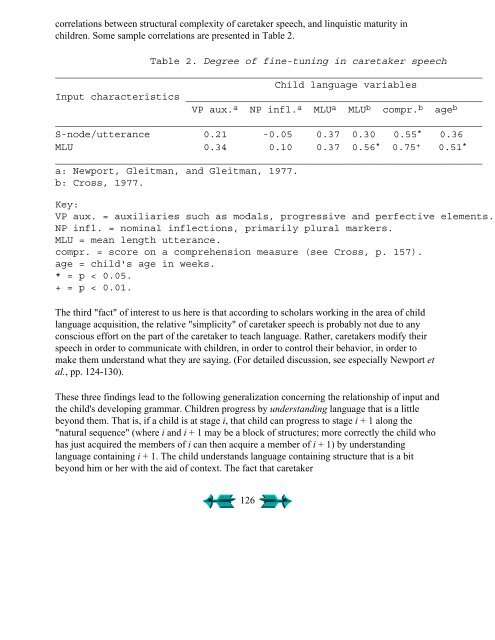Second Language Acquisition and Second ... - Stephen Krashen
Second Language Acquisition and Second ... - Stephen Krashen
Second Language Acquisition and Second ... - Stephen Krashen
Create successful ePaper yourself
Turn your PDF publications into a flip-book with our unique Google optimized e-Paper software.
correlations between structural complexity of caretaker speech, <strong>and</strong> linquistic maturity in<br />
children. Some sample correlations are presented in Table 2.<br />
Table 2. Degree of fine-tuning in caretaker speech<br />
________________________________________________________________________<br />
Child language variables<br />
Input characteristics __________________________________________________<br />
VP aux. a NP infl. a MLU a MLU b compr. b age b<br />
________________________________________________________________________<br />
S-node/utterance 0.21 -0.05 0.37 0.30 0.55 * 0.36<br />
MLU 0.34 0.10 0.37 0.56 * 0.75 + 0.51 *<br />
________________________________________________________________________<br />
a: Newport, Gleitman, <strong>and</strong> Gleitman, 1977.<br />
b: Cross, 1977.<br />
Key:<br />
VP aux. = auxiliaries such as modals, progressive <strong>and</strong> perfective elements.<br />
NP infl. = nominal inflections, primarily plural markers.<br />
MLU = mean length utterance.<br />
compr. = score on a comprehension measure (see Cross, p. 157).<br />
age = child's age in weeks.<br />
* = p < 0.05.<br />
+ = p < 0.01.<br />
The third "fact" of interest to us here is that according to scholars working in the area of child<br />
language acquisition, the relative "simplicity" of caretaker speech is probably not due to any<br />
conscious effort on the part of the caretaker to teach language. Rather, caretakers modify their<br />
speech in order to communicate with children, in order to control their behavior, in order to<br />
make them underst<strong>and</strong> what they are saying. (For detailed discussion, see especially Newport et<br />
al., pp. 124-130).<br />
These three findings lead to the following generalization concerning the relationship of input <strong>and</strong><br />
the child's developing grammar. Children progress by underst<strong>and</strong>ing language that is a little<br />
beyond them. That is, if a child is at stage i, that child can progress to stage i + 1 along the<br />
"natural sequence" (where i <strong>and</strong> i + 1 may be a block of structures; more correctly the child who<br />
has just acquired the members of i can then acquire a member of i + 1) by underst<strong>and</strong>ing<br />
language containing i + 1. The child underst<strong>and</strong>s language containing structure that is a bit<br />
beyond him or her with the aid of context. The fact that caretaker<br />
126











